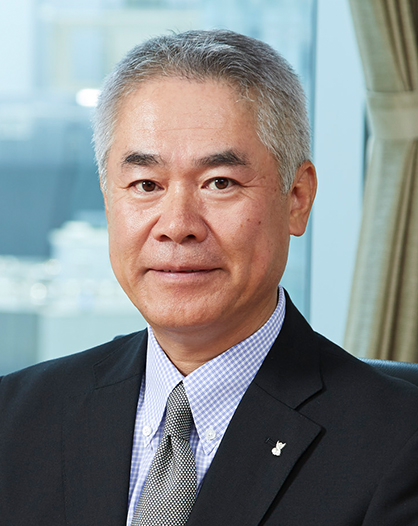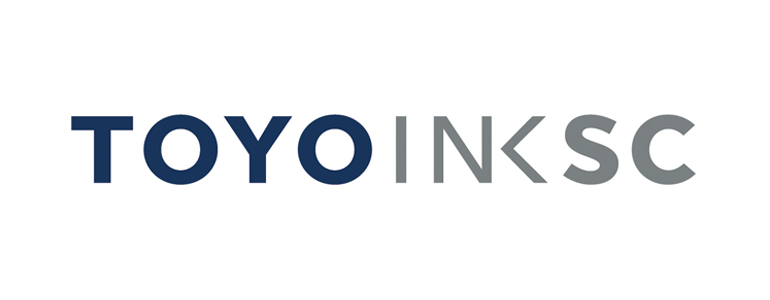| Toyo Ink SC Holdings, Co., Ltd. (4634) |
|
||||||||
Company |
Toyo Ink SC Holdings, Co., Ltd. |
||
Code No. |
4634 |
||
Exchange |
TSE 1st Section |
||
Industry |
Chemical (Manufacturing) |
||
President and CEO |
Katsumi Kitagawa |
||
Address |
2-2-1 Kyobashi, Chuo-ku, Tokyo |
||
Year-end |
End of December |
||
HP |
|||
* Share price as of closing on the end of September 4. Number of shares outstanding, ROE and BPS are as of the end of the previous term.
ROE is actual value for 9-months settlement and its12-months conversion value is 6.8%. * A 1-for-5 reverse split was conducted on July 1, 2018. DPS and PBR were calculated while taking into account the reverse split of shares. |
||||||||||||||||||||||||
|
|
* Estimates are those of the Company. Net income is net income attributable to the shareholders of the parent company.
The values of December 2017 are for 9 months.A 1-for-5 reverse split was conducted on July 1, 2018. The EPS and DPS for the term ending Dec. 2018 were calculated while considering the reverse split. Retroactive adjustment was not conducted. This Bridge Report provides Toyo Ink SC Holdings, Co., Ltd.'s financial updates of the second quarter of term ending Dec. 2018, and more.. |
| Key Points |
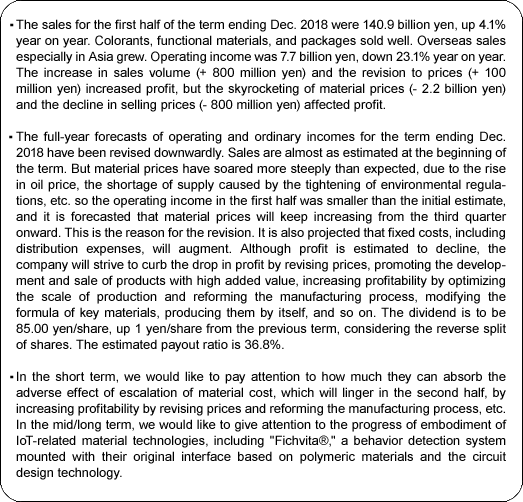 |
| Company Profile |
|
Toyo Ink SC Holdings is Japan's top manufacturer of printing inks. Using the processing technologies of pigments and resins that are the raw materials of inks, the Company manufactures various products such as LCD color filters and
electromagnetic shielding films. The Toyo Ink Group is comprised of Toyo Ink SC Holdings, 66 consolidated subsidiaries in and outside Japan, and 9 equity method affiliate companies. They are operating business in 22 countries around the world (The end of December 2017).Under the long-term scheme "Scientific Innovation Chain 2027 (SIC 27)," whose concept is to contribute to the improvement of sustainability of ordinary citizens, life, and the global environment by innovatively thinking, scientifically executing, and connecting each activity by each and every employee, it is aiming for a transformation to have a corporate structure that enables sustainable growth towards 2027.
【History】
The origin of Toyo Ink dates back to 1896, when founder Kamataro Kobayashi opened Kobayashi's Ink Shop as sole proprietorship in Nihonbashi, Tokyo. In 1907, it was reorganized and renamed as Toyo Ink Manufacturing Co., Ltd. During the Meiji period, many newspapers and magazines, including the Yomiuri Shimbun (founded in 1874) and the Asahi Shimbun (founded in 1879), were launched. The government also printed an increasing number of materials including textbooks to enhance educational levels under the policy of increasing wealth and military power. Under these circumstances, the demand for printing inks expanded rapidly.
Initially, inks in the Japanese market were mostly imported products; however, as the national policy favored high quality domestically produced inks, the Company, with its advanced technological skills, successfully expanded its business with clients such as the Printing Bureau of the Ministry of Finance and other government bodies, in addition to private printing companies. Exports also grew during the same time. The Company's rapid growth was also due in part to the early introduction of integrated manufacturing system from raw materials (pigments, resins) to finished products (printing inks). Another contributing factor may be that the Company, since its inception, had strong ties with Toppan Printing Co., Ltd., which, by then, was among Japan's largest printing companies. The Company survived the difficult times of the Great Kanto Earthquake and the World War II and experienced rapid growth again during the period of high economic growth after the war. The Company was listed on the Second Section of the Tokyo Stock Exchange in 1961 and moved to the First Section of the Tokyo Stock Exchange in 1967.
The Company is expanding its businesses from manufacturing of printing inks to other fields such as LCD film materials, using its wide range of technologies and know-how cultivated through manufacturing and processing of raw materials such as pigments and resins. In 2011, the Company adopted a holding company system for further expansion and growth of the Group, and changed its name to Toyo Ink SC Holdings, Co., Ltd..
【Corporate Philosophy】
The Toyo Ink Group's Corporate Philosophy was established in April 1993. It consists of three parts, namely, corporate philosophy, corporate policies, and guiding principles. The Philosophy embodies the original roots of the brand of the corporate group and serves as guidelines that each employee of the Group should always keep in mind and act on as a business professional. In April 2014, "improving shareholder satisfaction" was added to its guiding principles. With this revision, the Company is aiming to improve satisfaction of all stakeholders.
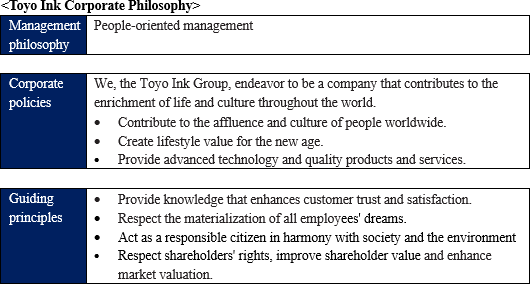 All employees must always carry this philosophy system printed on a credo card, read it out in the 5-minute meeting every week at each division, and repeatedly confirm its meaning through discussion. This way, the employees are expected to have deeper understanding and implement the philosophy.
Furthermore, the "Toyo Ink Group Corporate Philosophy" is printed on the first page of every single issue of the Company's in-house magazine, which is published for the Group's unity and circulated to the entire Group including the overseas locations. Also, the above-mentioned credo has "Japanese/English" version as well as "Chinese/English" version to share and spread the corporate philosophy globally.
【Market Environment】
◎ Overview
(Market trend)
The production value of the Japanese printing industry is declining especially in the realm of publication printing of newspapers and magazines as a result of increasing digitization and aliteracy.
In the realm of commercial printing, on the other hand, of posters, catalogues, fliers, POP, etc. demand is fairly steady. Furthermore, printing on food and pharmaceutical packages and plastic containers is steadily increasing at the compound annual growth rate (CAGR) of 2.42% from 2004 to 2017.
All employees must always carry this philosophy system printed on a credo card, read it out in the 5-minute meeting every week at each division, and repeatedly confirm its meaning through discussion. This way, the employees are expected to have deeper understanding and implement the philosophy.
Furthermore, the "Toyo Ink Group Corporate Philosophy" is printed on the first page of every single issue of the Company's in-house magazine, which is published for the Group's unity and circulated to the entire Group including the overseas locations. Also, the above-mentioned credo has "Japanese/English" version as well as "Chinese/English" version to share and spread the corporate philosophy globally.
【Market Environment】
◎ Overview
(Market trend)
The production value of the Japanese printing industry is declining especially in the realm of publication printing of newspapers and magazines as a result of increasing digitization and aliteracy.
In the realm of commercial printing, on the other hand, of posters, catalogues, fliers, POP, etc. demand is fairly steady. Furthermore, printing on food and pharmaceutical packages and plastic containers is steadily increasing at the compound annual growth rate (CAGR) of 2.42% from 2004 to 2017.
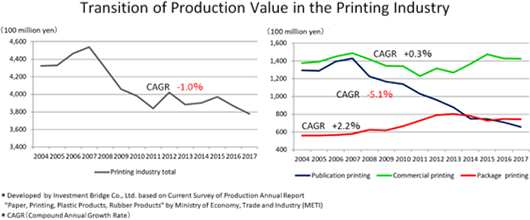 Meanwhile, overseas, especially in newly emerging countries, both printing on papers (offset printing) and printing on film of food packages (gravure printing, flexographic printing) are expected to grow, and the Company is focusing on responding to the demand.
As innovation of printing machine is progressing, quality of printing is enhancing. Overseas local inks, in many cases, cannot respond to such demand for high quality, which may lead to more demand of excellent Japanese ink.
(Printing houses and printing ink manufacturers)
According to the "Census of Manufactures 2017: Report by Industry" by METI, there were 10,589 business entities in the printing and related industries in 2016. 10,187 (96.2%) of them are small and medium-sized enterprises with fewer than 100 employees.
Meanwhile, overseas, especially in newly emerging countries, both printing on papers (offset printing) and printing on film of food packages (gravure printing, flexographic printing) are expected to grow, and the Company is focusing on responding to the demand.
As innovation of printing machine is progressing, quality of printing is enhancing. Overseas local inks, in many cases, cannot respond to such demand for high quality, which may lead to more demand of excellent Japanese ink.
(Printing houses and printing ink manufacturers)
According to the "Census of Manufactures 2017: Report by Industry" by METI, there were 10,589 business entities in the printing and related industries in 2016. 10,187 (96.2%) of them are small and medium-sized enterprises with fewer than 100 employees.
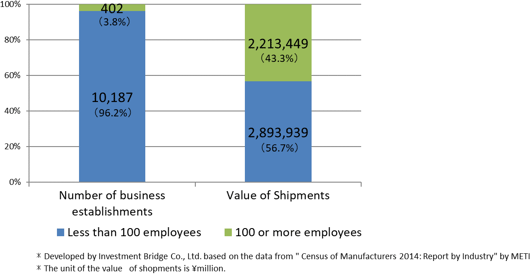 The Company's customers such as printing companies purchase printing inks and carry out printing. However, printing cannot be done simply by setting printing inks and papers and starting the machine. Printing companies are faced with needs such as "selection of the ink for the new types of paper," "producing special color" and "producing premium look," and challenges such as improving printing efficiency and taking environmental measures. The Company provides its customers with information on new products and various pieces of concerning these needs and challenges. Most of the 26,000 printing companies in Japan can hardly conduct business without such solutions. Therefore, printing ink manufacturers play a crucial role in the printing industry.
Thus, the Company's customers seek direct dealings with the Company. As a result, nearly 80% of the Company's domestic sales come from direct sales to its customers. These strong relationships with the customers are among the Company's major characteristics.
◎ Other companies in the industry
There are six major listed companies including Toyo Ink in the ink industry in Japan.
While (4631) DIC is the number one company in the world, Toyo Ink is the top runner in Japanese printing ink industry, and ranks first or second in most product categories. Globally, the Company is ranked third (The second is a European firm). (4633) SAKATA INX is the second largest shareholder of the Company. The Company and SAKATA INX complement each other mainly in logistical aspects. The two companies concluded a capital and business alliance agreement in 2000.
The Company's customers such as printing companies purchase printing inks and carry out printing. However, printing cannot be done simply by setting printing inks and papers and starting the machine. Printing companies are faced with needs such as "selection of the ink for the new types of paper," "producing special color" and "producing premium look," and challenges such as improving printing efficiency and taking environmental measures. The Company provides its customers with information on new products and various pieces of concerning these needs and challenges. Most of the 26,000 printing companies in Japan can hardly conduct business without such solutions. Therefore, printing ink manufacturers play a crucial role in the printing industry.
Thus, the Company's customers seek direct dealings with the Company. As a result, nearly 80% of the Company's domestic sales come from direct sales to its customers. These strong relationships with the customers are among the Company's major characteristics.
◎ Other companies in the industry
There are six major listed companies including Toyo Ink in the ink industry in Japan.
While (4631) DIC is the number one company in the world, Toyo Ink is the top runner in Japanese printing ink industry, and ranks first or second in most product categories. Globally, the Company is ranked third (The second is a European firm). (4633) SAKATA INX is the second largest shareholder of the Company. The Company and SAKATA INX complement each other mainly in logistical aspects. The two companies concluded a capital and business alliance agreement in 2000.
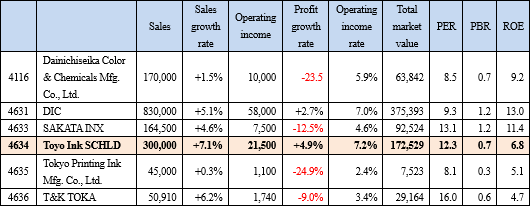 *Sales and operating income are based on estimations of each company for this FY. ROE and PBR are based on actual results of the previous term end. Unit: Million Yen, Times. Total market value is as of closing on August 31, 2018.
*Since Toyo Ink SCHLD was based on a nine-month settlement due to change in the settlement term of previous fiscal year, the sales growth rate and the profit growth rate are comparison with the actual values of 12-month conversion (announced by the company). ROE is the 12-month conversion value for the term ended Dec. 2017.
【Business Contents】
◎ Concerning "printing inks"
Followings are the summary of printing inks, one of the major product categories of the Company, categorized by "raw materials" and "types and purposes of use." *Sales and operating income are based on estimations of each company for this FY. ROE and PBR are based on actual results of the previous term end. Unit: Million Yen, Times. Total market value is as of closing on August 31, 2018.
*Since Toyo Ink SCHLD was based on a nine-month settlement due to change in the settlement term of previous fiscal year, the sales growth rate and the profit growth rate are comparison with the actual values of 12-month conversion (announced by the company). ROE is the 12-month conversion value for the term ended Dec. 2017.
【Business Contents】
◎ Concerning "printing inks"
Followings are the summary of printing inks, one of the major product categories of the Company, categorized by "raw materials" and "types and purposes of use."
 High-level diffusion technologies are required when various inks are produced by combining the above three raw materials.
Since its foundation, the Company has also been expanding its business categories by exploring application of these raw materials in the process of manufacturing them.
High-level diffusion technologies are required when various inks are produced by combining the above three raw materials.
Since its foundation, the Company has also been expanding its business categories by exploring application of these raw materials in the process of manufacturing them.
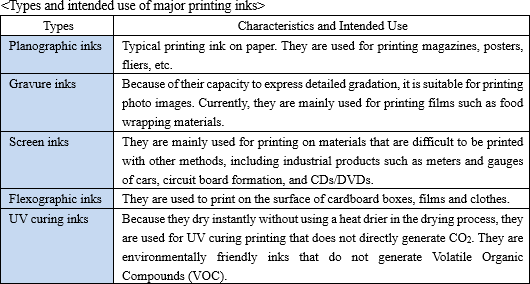 ◎ Business segments
The business activities of the Company are classified into four segments: the "Colorants & Functional Materials Related Business," "Polymers & Coatings Related Business," "Printing & Information Related Business", and "Packaging Materials Related Business".
The "Printing & Information Related Business" mainly deals with planographic inks that are used for printing on papers (offset inks, etc.). The "Packaging Materials Related Business" deals with gravure inks and flexographic inks that are used for printing on films of food packages. The "Colorants & Functional Materials Related Business" deals with products related to pigments that are also the raw materials of printing inks as core materials. The "Polymers & Coatings Related Business" began with resins that are the main raw materials of inks and their design technologies. ◎ Business segments
The business activities of the Company are classified into four segments: the "Colorants & Functional Materials Related Business," "Polymers & Coatings Related Business," "Printing & Information Related Business", and "Packaging Materials Related Business".
The "Printing & Information Related Business" mainly deals with planographic inks that are used for printing on papers (offset inks, etc.). The "Packaging Materials Related Business" deals with gravure inks and flexographic inks that are used for printing on films of food packages. The "Colorants & Functional Materials Related Business" deals with products related to pigments that are also the raw materials of printing inks as core materials. The "Polymers & Coatings Related Business" began with resins that are the main raw materials of inks and their design technologies.
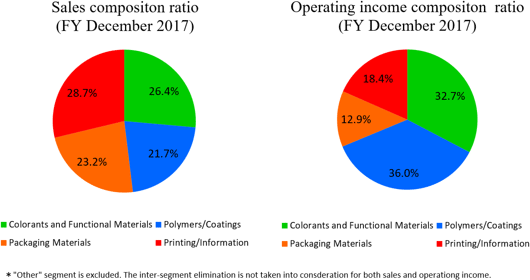 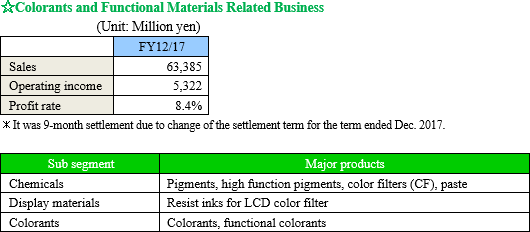 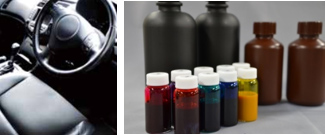 Based on the organic pigments that are the main raw materials for printing inks, and by integrating their color material technologies, organic chemical synthetic technologies and high-level dispersion technologies, the Company offers materials that are used in various fields. Especially, it created higher functional LCD color filter materials using their nano-level dispersion technologies through integration of technologies that have been accumulated from their ink and painting materials production experiences. Furthermore, the Company's dispersion processing technologies are used not only for organic pigments but also for inorganic materials such as carbon nanotube (CNT), which leads to expansion of its business in the new energy field such as secondary battery materials. They constitute about 40% of the Company's operating income.
Based on the organic pigments that are the main raw materials for printing inks, and by integrating their color material technologies, organic chemical synthetic technologies and high-level dispersion technologies, the Company offers materials that are used in various fields. Especially, it created higher functional LCD color filter materials using their nano-level dispersion technologies through integration of technologies that have been accumulated from their ink and painting materials production experiences. Furthermore, the Company's dispersion processing technologies are used not only for organic pigments but also for inorganic materials such as carbon nanotube (CNT), which leads to expansion of its business in the new energy field such as secondary battery materials. They constitute about 40% of the Company's operating income.
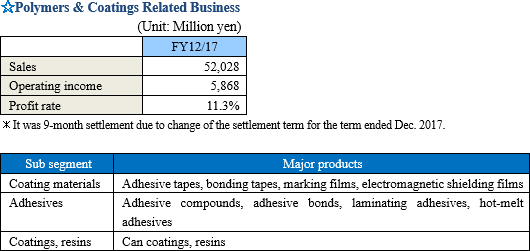 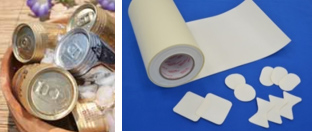 For this segment, the Company develops functional resins as the core materials with different functional features. Using unique technologies that have been developed for many years, the Company creates new functions to cultivate new demand and open new markets in electronics, energy, health care and other fields.
For this segment, the Company develops functional resins as the core materials with different functional features. Using unique technologies that have been developed for many years, the Company creates new functions to cultivate new demand and open new markets in electronics, energy, health care and other fields.
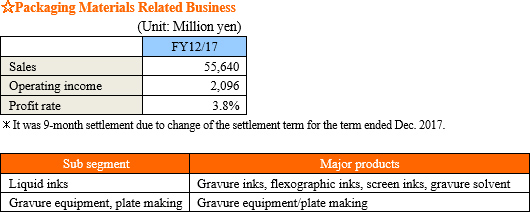 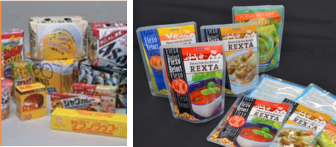 For this segment, the Company deals with printing inks and equipment used in packages such as gravure printing, flexographic graphic printing and screen-printing. In the field of food packaging, etc., the Company is dedicated to developing environmentally friendly products using water-based ink to assure their safety to the consumers.
For this segment, the Company deals with printing inks and equipment used in packages such as gravure printing, flexographic graphic printing and screen-printing. In the field of food packaging, etc., the Company is dedicated to developing environmentally friendly products using water-based ink to assure their safety to the consumers.
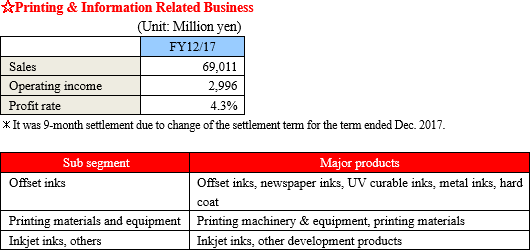 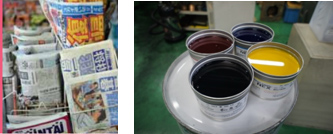 This segment is the core segment of the Company since its establishment. For this segment, the Company deals mainly with printing inks used for printing on paper.
The Company offers not only printing inks but also sales of machinery/equipment, support for streamlining customers' printing process, and support and tools for color management and color universal design.
◎ Overseas expansion
While the Company is improving profitability by offering high-value-added products in the Japanese market, where a rapid growth is not expected, it is aggressively expanding its business from both production and sales perspectives in the overseas market where future growth is expected.
Development of its overseas manufacturing structures was almost completed during the previous Midterm Business Plan, and the Company is carrying out both raw material procurement and production at local sites.
As of the end of Decembewr 2017, the Company has about 50 overseas consolidated subsidiaries and 50 production sites in a wide range of countries around the world.
This segment is the core segment of the Company since its establishment. For this segment, the Company deals mainly with printing inks used for printing on paper.
The Company offers not only printing inks but also sales of machinery/equipment, support for streamlining customers' printing process, and support and tools for color management and color universal design.
◎ Overseas expansion
While the Company is improving profitability by offering high-value-added products in the Japanese market, where a rapid growth is not expected, it is aggressively expanding its business from both production and sales perspectives in the overseas market where future growth is expected.
Development of its overseas manufacturing structures was almost completed during the previous Midterm Business Plan, and the Company is carrying out both raw material procurement and production at local sites.
As of the end of Decembewr 2017, the Company has about 50 overseas consolidated subsidiaries and 50 production sites in a wide range of countries around the world.
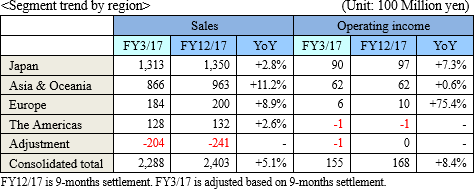 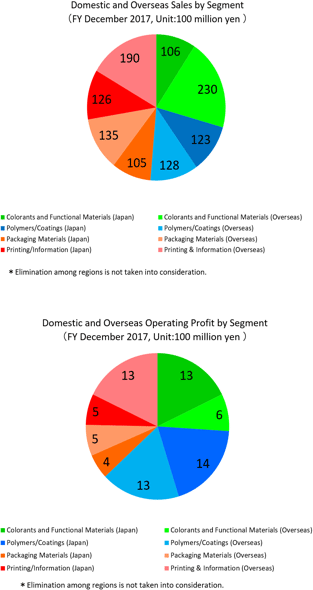 【ROE Analysis】 【ROE Analysis】
 The 12-months conversion value for the term ended Dec. 2017 is 6.8%.
All 3 elements declined and ROE fell below 5%. In general, it is desirable to boost profitability and efficiency to achieve an ROE of 8%, which is said to be the value that should be pursued by Japanese companies.
【Characteristics and Strengths】
(1) Strong technological edge
As described above, the Company has been manufacturing in-house pigments and resins, which are the raw materials of printing inks. Its technological capacities form the basis of high quality printing ink production and lead to expansion of business areas and product range such as, LCD color filter materials, adhesive bonds and adhesive compounds.
(2) Excellent problem solving skills
One of the reasons for the Company to be at the top of the Japanese printing inks industry is its excellent problem solving capability in all aspects of printing.
The Company not only produces and supplies printing inks but also studies elements related to "printing" as a whole including plate making and images. Such efforts enable the Company to make technological proposals, demonstrate advanced service skills, and obtain high customer satisfaction.
(3) Environmental concerns
The Company is a forerunner in CO2 emission reduction as well as production of eco-friendly inks such as non-VOC inks, water-base inks, and UV inks. In the newly developed countries, too, the environmental regulations are becoming tighter, and the needs for environmentally friendly products are increasing. The Company is also working on assuring safety such as chemical substances control and manufacturing a line of products that meet the Swiss Ordinance, ahead of other companies.
(4) Uniqueness of management strategies
The Company considers M&A as one of the options for exploring new markets with its technological edge, if M&A is expected to bring synergy effects to the Company. However, it is not intending to implement M&A just to increase the size of businesses. It is also taking an initiative in the printing ink industry to establish "local production for local consumption" policy in the overseas market for enhancing efficiency (e.g. reduction in transport mileage) and social contribution (e.g. utilization of local products) purposes.
The 12-months conversion value for the term ended Dec. 2017 is 6.8%.
All 3 elements declined and ROE fell below 5%. In general, it is desirable to boost profitability and efficiency to achieve an ROE of 8%, which is said to be the value that should be pursued by Japanese companies.
【Characteristics and Strengths】
(1) Strong technological edge
As described above, the Company has been manufacturing in-house pigments and resins, which are the raw materials of printing inks. Its technological capacities form the basis of high quality printing ink production and lead to expansion of business areas and product range such as, LCD color filter materials, adhesive bonds and adhesive compounds.
(2) Excellent problem solving skills
One of the reasons for the Company to be at the top of the Japanese printing inks industry is its excellent problem solving capability in all aspects of printing.
The Company not only produces and supplies printing inks but also studies elements related to "printing" as a whole including plate making and images. Such efforts enable the Company to make technological proposals, demonstrate advanced service skills, and obtain high customer satisfaction.
(3) Environmental concerns
The Company is a forerunner in CO2 emission reduction as well as production of eco-friendly inks such as non-VOC inks, water-base inks, and UV inks. In the newly developed countries, too, the environmental regulations are becoming tighter, and the needs for environmentally friendly products are increasing. The Company is also working on assuring safety such as chemical substances control and manufacturing a line of products that meet the Swiss Ordinance, ahead of other companies.
(4) Uniqueness of management strategies
The Company considers M&A as one of the options for exploring new markets with its technological edge, if M&A is expected to bring synergy effects to the Company. However, it is not intending to implement M&A just to increase the size of businesses. It is also taking an initiative in the printing ink industry to establish "local production for local consumption" policy in the overseas market for enhancing efficiency (e.g. reduction in transport mileage) and social contribution (e.g. utilization of local products) purposes.
|
| Second Quarter of Fiscal Year December 2018 Earnings Results |
 Sales grew, but profit declined.
Sales were 140.9 billion yen, up 4.1% year on year. Colorants, functional materials, and packages sold well. Overseas sales especially in Asia grew. Operating income was 7.7 billion yen, down 23.1% year on year. The increase in sales volume (+ 800 million yen) and the revision to prices (+ 100 million yen) increased profit, but the skyrocketing of material prices, including the prices of solvents due to the increase in naphtha price (- 2.2 billion yen) and the decline in selling prices (- 800 million yen) affected profit. Sales grew, but profit declined.
Sales were 140.9 billion yen, up 4.1% year on year. Colorants, functional materials, and packages sold well. Overseas sales especially in Asia grew. Operating income was 7.7 billion yen, down 23.1% year on year. The increase in sales volume (+ 800 million yen) and the revision to prices (+ 100 million yen) increased profit, but the skyrocketing of material prices, including the prices of solvents due to the increase in naphtha price (- 2.2 billion yen) and the decline in selling prices (- 800 million yen) affected profit.
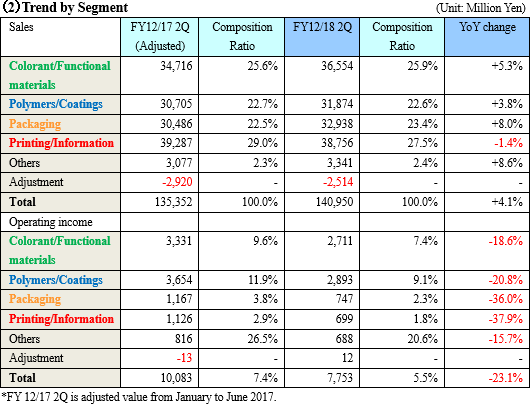 ☆Colorants and Functional Materials Related Business
Sales increased, but profit decreased. The sales of media materials, for which the company makes intensive efforts, declined, and the scale of functional dispersion materials has expanded considerably although it is still small.
(Chemicals)
The sales of pigments were sluggish in the printing field, but grew in the coating field. However, there was an adverse effect of skyrocketing material prices.
(Display materials)
The domestic market is shrinking, but the performance of mainly large display panels was healthy as a whole in the Taiwanese and Chinese markets. The market share in Taiwan increased, and new Chinese clients adopted the products of the company.
(Colorants)
Favorable performance was seen for packages in Japan, and OA equipment outside Japan. But, there was an adverse effect of skyrocketing material prices.
(Functional dispersion materials)
The carbon dispersion materials for lithium-ion batteries in Japan sold well, and the sales of insulated black dispersion materials grew.
☆Polymers & Coatings Related Business
Sales rose, but profit dropped. The sales of electronic and optical products, for which company makes intensive efforts, grew by double digits.
(Coating materials)
The sales promotion of conductive adhesive films for smartphones and electronics-related functional films progressed.
(Adhesives)
The sales of adhesives for electronic products increased healthily, and the sales of laminate adhesives for packaging and lithium-ion batteries grew inside and outside Japan, but they were affected by skyrocketing material prices.
(Coatings and resins)
As for can coatings, environmentally friendly products sold well in the European and U.S. markets.
Inside Japan, sales were sluggish, because of the stagnant demand for canned coffee, etc.
☆Packaging Materials Related Business
Sales grew, but profit dropped. Overseas liquid ink, for which the company makes intensive efforts, performed well.
(Soft packaging materials)
As the domestic market was healthy, the sales of biomass products grew.
Outside Japan, the Chinese market was stagnant, but sales increased in Southeast Asia and India.
Both domestic and overseas results were affected by the rise in material cost.
(Building materials)
Domestic sales and export were healthy, but affected by the rise in material cost.
(Cardboard)
The market was favorable, but the decrease in the printing area got out of hand, and produced significant adverse effects.
☆Printing & Information Related Business
Sales and profit declined. Functional inks, for which the company makes intensive efforts, performed well.
(Offset inks)
Domestic performance was sluggish, due to the weakening of demand for flyers, publications, and newspapers. The company promoted sales of new products, but could not cover it.
Outside Japan, sales promotion in India progressed, and export increased. In South America, the company promoted sheet-fed inks.
There was an adverse effect of skyrocketing material prices.
(Functional inks)
The domestic and overseas markets of UV inks for energy saving and commerce expanded, and the company promoted UV inks for paper containers. The company strived to reduce costs, but there was an adverse effect of skyrocketing material prices.
As for inkjet inks, large-scale transactions adopting the products of the company progressed, as it promoted UV products in Europe, China, etc. and developed water-based inks inside Japan. ☆Colorants and Functional Materials Related Business
Sales increased, but profit decreased. The sales of media materials, for which the company makes intensive efforts, declined, and the scale of functional dispersion materials has expanded considerably although it is still small.
(Chemicals)
The sales of pigments were sluggish in the printing field, but grew in the coating field. However, there was an adverse effect of skyrocketing material prices.
(Display materials)
The domestic market is shrinking, but the performance of mainly large display panels was healthy as a whole in the Taiwanese and Chinese markets. The market share in Taiwan increased, and new Chinese clients adopted the products of the company.
(Colorants)
Favorable performance was seen for packages in Japan, and OA equipment outside Japan. But, there was an adverse effect of skyrocketing material prices.
(Functional dispersion materials)
The carbon dispersion materials for lithium-ion batteries in Japan sold well, and the sales of insulated black dispersion materials grew.
☆Polymers & Coatings Related Business
Sales rose, but profit dropped. The sales of electronic and optical products, for which company makes intensive efforts, grew by double digits.
(Coating materials)
The sales promotion of conductive adhesive films for smartphones and electronics-related functional films progressed.
(Adhesives)
The sales of adhesives for electronic products increased healthily, and the sales of laminate adhesives for packaging and lithium-ion batteries grew inside and outside Japan, but they were affected by skyrocketing material prices.
(Coatings and resins)
As for can coatings, environmentally friendly products sold well in the European and U.S. markets.
Inside Japan, sales were sluggish, because of the stagnant demand for canned coffee, etc.
☆Packaging Materials Related Business
Sales grew, but profit dropped. Overseas liquid ink, for which the company makes intensive efforts, performed well.
(Soft packaging materials)
As the domestic market was healthy, the sales of biomass products grew.
Outside Japan, the Chinese market was stagnant, but sales increased in Southeast Asia and India.
Both domestic and overseas results were affected by the rise in material cost.
(Building materials)
Domestic sales and export were healthy, but affected by the rise in material cost.
(Cardboard)
The market was favorable, but the decrease in the printing area got out of hand, and produced significant adverse effects.
☆Printing & Information Related Business
Sales and profit declined. Functional inks, for which the company makes intensive efforts, performed well.
(Offset inks)
Domestic performance was sluggish, due to the weakening of demand for flyers, publications, and newspapers. The company promoted sales of new products, but could not cover it.
Outside Japan, sales promotion in India progressed, and export increased. In South America, the company promoted sheet-fed inks.
There was an adverse effect of skyrocketing material prices.
(Functional inks)
The domestic and overseas markets of UV inks for energy saving and commerce expanded, and the company promoted UV inks for paper containers. The company strived to reduce costs, but there was an adverse effect of skyrocketing material prices.
As for inkjet inks, large-scale transactions adopting the products of the company progressed, as it promoted UV products in Europe, China, etc. and developed water-based inks inside Japan.
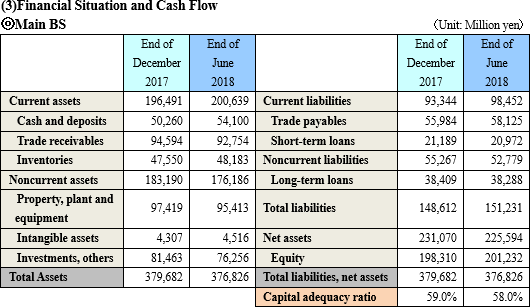 Current assets grew 4.1 billion yen from the end of the previous term, due to the increase in cash and deposits, etc. Noncurrent assets dropped 7 billion yen, due to the decline in investment securities caused by the decrease in share prices, etc. Total assets decreased 2.8 billion yen to 376.8 billion yen. Total liabilities were 151.2 billion yen, up 2.6 billion yen from the end of the previous term, due to the increase in trade payables, etc. Net assets declined 5.4 billion yen to 225.5 billion yen, as retained earnings rose, but foreign currency translation adjustment turned negative due to the yen appreciation.
As a result, capital adequacy ratio decreased 1.0 point from 59.0% at the end of the previous term to 58.0%.
(4) Topics
◎ The cafeteria of the headquarters received an upfront certification in the "healthy meal and eating environment" certification system.
The cafeteria "Kitchen Rion" of the headquarters received an advance certification as an exemplary facility for providing meals in the "healthy meal and eating environment" certification system, which started accepting applications in April 2018.
The "healthy meal and eating environment" certification system is a system for certifying restaurants and business facilities that continuously serve "Smart Meals (healthy food)*" in a healthy space (where nutrition information is provided and measures for preventing passive smoking are taken) at restaurants or cafeterias or via home meal replacements.
After receiving a report of "the workshop for ideal healthy meals that could support the longevity of Japanese people" of the Ministry of Health, Labour and Welfare, the director of Health Service Bureau issued a notice titled "Standards for meals served for the purpose of preventing lifestyle-related diseases and enhancing health" in Sep. 2015. The "Healthy Meal and Eating Environment" Consortium composed of seven academic associations, including the Japanese Society of Nutrition and Dietetics, the Japanese Society of Hypertension, and the Japan Diabetes Society, screens and certifies applicants.
The Toyo Ink SC Group designs and operates the new cafeteria "Kitchen Rion," which was opened in parallel with the relocation of Kyobashi Head Office in 2016, under the policy of supporting the improvement of health by increasing the convenience for employees, energizing communication, and addressing the issue about employees' dietary habits based on a course of action for fulfilling the social responsibility of the group: "To foster a working environment where employees can work comfortably and achieve self-actualization."
Especially, with regard to health, the company implemented concrete measures, such as the provision of side dishes including mainly vegetables and soybeans, the discontinuance of provision of pickles, which increase salt intake, the provision of low-sodium and oil-free seasonings, and the introduction of healthy rice served on a day-by-day rotating basis and a salad bar, in cooperation with Seiyo Food-Compass Group, Inc., which undertakes the operation of cafeterias.
As these multifaceted efforts were highly evaluated, the company received an advance certification as an exemplary facility for providing meals before the full-scale start of the certification system.
From now on, the company plans to utilize this certification system also at other business establishments, and conduct activities for supporting health improvement from cafeterias.
*Smart Meal
It means a nutritionally balanced meal including healthy ingredients.
The standards for Smart Meals are based on "Standards for meals served for the purpose of preventing lifestyle-related diseases and enhancing health (Sep. 2015)" of the Ministry of Health, Labour and Welfare and the 2015 edition of the dietary reference intakes, and were determined after analyzing the actual healthy menus of 4 companies that serve meals. The standards are composed of dishes and food products produced while considering energy amount, the combination of dishes, sodium chloride equivalent, etc.
Current assets grew 4.1 billion yen from the end of the previous term, due to the increase in cash and deposits, etc. Noncurrent assets dropped 7 billion yen, due to the decline in investment securities caused by the decrease in share prices, etc. Total assets decreased 2.8 billion yen to 376.8 billion yen. Total liabilities were 151.2 billion yen, up 2.6 billion yen from the end of the previous term, due to the increase in trade payables, etc. Net assets declined 5.4 billion yen to 225.5 billion yen, as retained earnings rose, but foreign currency translation adjustment turned negative due to the yen appreciation.
As a result, capital adequacy ratio decreased 1.0 point from 59.0% at the end of the previous term to 58.0%.
(4) Topics
◎ The cafeteria of the headquarters received an upfront certification in the "healthy meal and eating environment" certification system.
The cafeteria "Kitchen Rion" of the headquarters received an advance certification as an exemplary facility for providing meals in the "healthy meal and eating environment" certification system, which started accepting applications in April 2018.
The "healthy meal and eating environment" certification system is a system for certifying restaurants and business facilities that continuously serve "Smart Meals (healthy food)*" in a healthy space (where nutrition information is provided and measures for preventing passive smoking are taken) at restaurants or cafeterias or via home meal replacements.
After receiving a report of "the workshop for ideal healthy meals that could support the longevity of Japanese people" of the Ministry of Health, Labour and Welfare, the director of Health Service Bureau issued a notice titled "Standards for meals served for the purpose of preventing lifestyle-related diseases and enhancing health" in Sep. 2015. The "Healthy Meal and Eating Environment" Consortium composed of seven academic associations, including the Japanese Society of Nutrition and Dietetics, the Japanese Society of Hypertension, and the Japan Diabetes Society, screens and certifies applicants.
The Toyo Ink SC Group designs and operates the new cafeteria "Kitchen Rion," which was opened in parallel with the relocation of Kyobashi Head Office in 2016, under the policy of supporting the improvement of health by increasing the convenience for employees, energizing communication, and addressing the issue about employees' dietary habits based on a course of action for fulfilling the social responsibility of the group: "To foster a working environment where employees can work comfortably and achieve self-actualization."
Especially, with regard to health, the company implemented concrete measures, such as the provision of side dishes including mainly vegetables and soybeans, the discontinuance of provision of pickles, which increase salt intake, the provision of low-sodium and oil-free seasonings, and the introduction of healthy rice served on a day-by-day rotating basis and a salad bar, in cooperation with Seiyo Food-Compass Group, Inc., which undertakes the operation of cafeterias.
As these multifaceted efforts were highly evaluated, the company received an advance certification as an exemplary facility for providing meals before the full-scale start of the certification system.
From now on, the company plans to utilize this certification system also at other business establishments, and conduct activities for supporting health improvement from cafeterias.
*Smart Meal
It means a nutritionally balanced meal including healthy ingredients.
The standards for Smart Meals are based on "Standards for meals served for the purpose of preventing lifestyle-related diseases and enhancing health (Sep. 2015)" of the Ministry of Health, Labour and Welfare and the 2015 edition of the dietary reference intakes, and were determined after analyzing the actual healthy menus of 4 companies that serve meals. The standards are composed of dishes and food products produced while considering energy amount, the combination of dishes, sodium chloride equivalent, etc.
|
| Fiscal Year December 2018 Earnings Estimates |
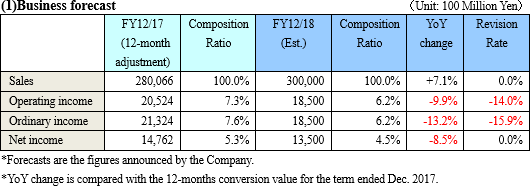 Downward revision to the estimated operating and ordinary incomes
Sales are almost as estimated at the beginning of the term. But material prices have soared more steeply than expected, due to the rise in oil price, the shortage of supply caused by the tightening of environmental regulations, etc. so the operating income in the first half fell below the initial estimate. It is forecasted that material prices will keep increasing from the third quarter onward. This is the reason for the downward revision to the estimated operating and ordinary incomes.
The company estimates that the effect of material prices in the second half will amount to 2.3 billion yen, larger than that in the first half: 2.2 billion yen. It is also projected that fixed costs, including distribution expenses, will augment.
Profit is estimated to decline, but the company will strive to revise prices (whose effect was 100 million yen in the first half, and is estimated to be 800 million yen in the second half), promote the development and sale of products with high added value, increase profitability by optimizing the scale of production and reforming the manufacturing process, modify the formula of key materials, produce them by itself, and so on.
The dividend is to be 85.00 yen/share, up 1 yen/share from the previous term, considering the reverse split of shares. The estimated payout ratio is 36.8%.
There is no revision to the assumed exchange rates: 1 US dollar = 110 yen (112.0 yen on average in the previous term), 1 euro = 130 yen (127.2 yen on average in the previous term), and 1 yuan = 17.0 yen (16.6 yen on average in the previous term). Downward revision to the estimated operating and ordinary incomes
Sales are almost as estimated at the beginning of the term. But material prices have soared more steeply than expected, due to the rise in oil price, the shortage of supply caused by the tightening of environmental regulations, etc. so the operating income in the first half fell below the initial estimate. It is forecasted that material prices will keep increasing from the third quarter onward. This is the reason for the downward revision to the estimated operating and ordinary incomes.
The company estimates that the effect of material prices in the second half will amount to 2.3 billion yen, larger than that in the first half: 2.2 billion yen. It is also projected that fixed costs, including distribution expenses, will augment.
Profit is estimated to decline, but the company will strive to revise prices (whose effect was 100 million yen in the first half, and is estimated to be 800 million yen in the second half), promote the development and sale of products with high added value, increase profitability by optimizing the scale of production and reforming the manufacturing process, modify the formula of key materials, produce them by itself, and so on.
The dividend is to be 85.00 yen/share, up 1 yen/share from the previous term, considering the reverse split of shares. The estimated payout ratio is 36.8%.
There is no revision to the assumed exchange rates: 1 US dollar = 110 yen (112.0 yen on average in the previous term), 1 euro = 130 yen (127.2 yen on average in the previous term), and 1 yuan = 17.0 yen (16.6 yen on average in the previous term).
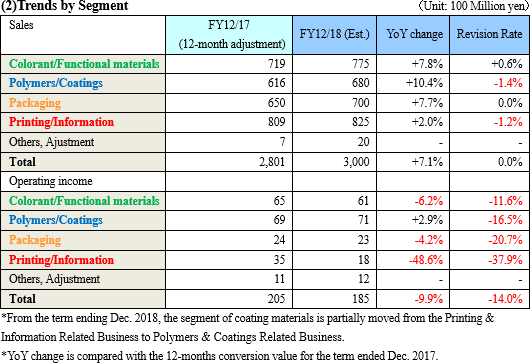 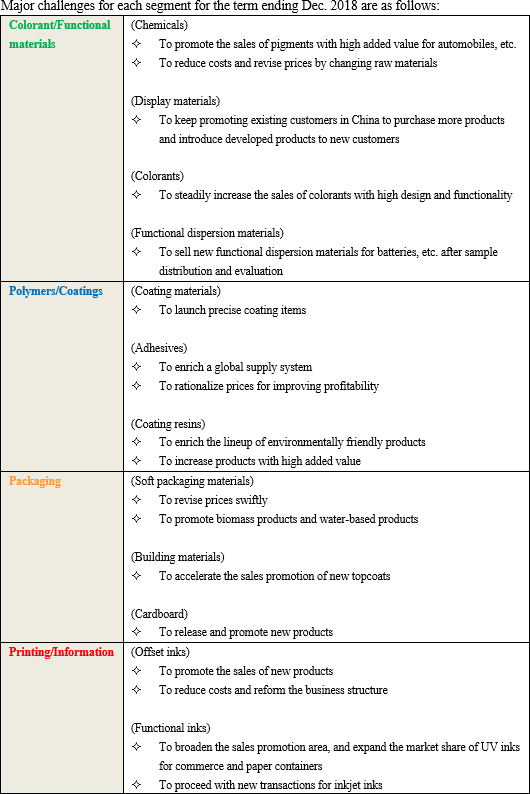 (3) Topics
◎ Exhibitions around the world
Toyo Ink SC holds exhibitions around the world, for introducing its technologies and characteristic products to many stakeholders, including clients and business partners.
In the second half of this term, the company will exhibit mainly inks and adhesives for packages in Myanmar in Sep., Tokyo in Oct., Shanghai in Oct., and Istanbul in Oct. to Nov. In Dec., the company plans to showcase decorative materials for auto interiors, hard coats, etc. at the highly functional film exposition in Makuhari Messe. The company will conduct active sales promotion in promising regions, including Myanmar, in which the company decided to operate business, and promising business domains.
In addition, the company holds "Toyo Ink Group Private Show" in Tokyo in May every year.
On May 30 this year, "Toyo Ink Group Private Show 2018" was held in Tokyo International Forum, attracting about 2,100 visitors. At this exhibition, about 60 booths were built, and as high-priority themes, they set "Residential Zone" for displaying packages of food products and daily necessities, and residential space-related goods, and "Transportation Zone" for introducing functional products for comfortable, safe travel by car, for the purposes of introducing their efforts to research, develop, and commercialize products and solutions for creating and developing new businesses.
At the venue, they also showcased "Fichvita®," a behavior detection system, which is expected to contribute to IoT-related business, and attracted attention from many visitors. (3) Topics
◎ Exhibitions around the world
Toyo Ink SC holds exhibitions around the world, for introducing its technologies and characteristic products to many stakeholders, including clients and business partners.
In the second half of this term, the company will exhibit mainly inks and adhesives for packages in Myanmar in Sep., Tokyo in Oct., Shanghai in Oct., and Istanbul in Oct. to Nov. In Dec., the company plans to showcase decorative materials for auto interiors, hard coats, etc. at the highly functional film exposition in Makuhari Messe. The company will conduct active sales promotion in promising regions, including Myanmar, in which the company decided to operate business, and promising business domains.
In addition, the company holds "Toyo Ink Group Private Show" in Tokyo in May every year.
On May 30 this year, "Toyo Ink Group Private Show 2018" was held in Tokyo International Forum, attracting about 2,100 visitors. At this exhibition, about 60 booths were built, and as high-priority themes, they set "Residential Zone" for displaying packages of food products and daily necessities, and residential space-related goods, and "Transportation Zone" for introducing functional products for comfortable, safe travel by car, for the purposes of introducing their efforts to research, develop, and commercialize products and solutions for creating and developing new businesses.
At the venue, they also showcased "Fichvita®," a behavior detection system, which is expected to contribute to IoT-related business, and attracted attention from many visitors.
|
| Mid-Term Business Plan "SIC-I" and Main Efforts in the First Year |
|
(1) Global expansion
Toyo Ink SC aims to increase the ratio of overseas sales to over 50% as soon as possible.
◎ Promotion of package-related products
The company aims to increase sales by 10 billion yen between 2017 and 2020.
In Myanmar, the company had conducted business by exporting products from surrounding countries, but through the easing of regulations, it became possible to establish a corporation there. Then, the company founded a company for manufacturing and selling inks and laminate adhesives in Aug. 2018. Its operation is scheduled to begin within 2019.
In addition, the company is upgrading production equipment for gravure inks. In Vietnam, the factory was improved in June, boosting production capacity 2.3 times. In Malaysia, a factory will be completed in Oct., increasing production capacity 1.4 times.
◎ Expansion of its business domain for enhancing its earning capacity
The company aims to increase sales by 5.1 billion yen between 2017 and 2020.
In India, in order to meet a wide range of growing needs, the company will expand its business by broadening and diversifying its business domain, constructing a new factory for colorants in Jul. 2018, producing adhesives there, and so on in addition to the promotion of inks.
The company acquired land for a new factory to enhance production capacity for each product and start a new business in Turkey, with the aim of achieving the largest market share and developing its brand in Turkey, which is rapidly growing, and surrounding areas (the Middle East, Africa, Central Asia, Eastern Europe, etc.), but construction is suspended, due to the steep weakening of the Turkish lira due to the tension between the U.S. and Turkey.
(2) Expansion of new products (coloring and functional materials)
The company aims to increase sales in the fields of mobility, electronics, and design, by enriching the product lineup through the evolution of dispersion and surface processing technologies, which are the company's core technologies, for carbon materials, inorganic particles, and metallic particles.
◎ Mobility
Toyo Ink SC aims to achieve sales of 3 billion yen in fiscal 2020.
The company is actively promoting the sales of "carbon for lithium-ion batteries and carbon nanotube conductive dispersion liquids," which can realize high conductivity and high durability for lithium-ion batteries with a low additive amount, in the U.S. and China.
The company is also concentrating on "inorganic particle dispersion liquids for automotive glass interlayers," which can block heat rays and visible light while maintaining high transparency.
◎ Electronics
Toyo Ink SC aims to achieve sales of 1 billion yen in fiscal 2020.
The company is promoting "an inorganic particle dispersion liquid for the transparent PI resin of foldable displays," which can improve physical properties and adjust coloration while keeping high transparency, and "a metallic particle dispersion liquid for inductors," which actualizes magnetic permeability through high dispersion and elaborate filling and contributes to the downsizing of inductors.
◎ Design
The company aims to achieve sales of 1 billion yen in fiscal 2020.
It concentrates on "jet-black materials (color branding)," which can actualize the black color with high added value for a broad range of purposes of use. It will organize a consortium composed of paint manufacturers, end manufacturers, designers, and others, and then proceed with the brand development for the black color with high added value through open innovation.
In addition, "the master batch for frosted bottles," which can embody bottles with a new texture through ordinary molding without post-production processing, is expected to perform well.
(3) Expansion of new products (polymers and coating)
The company aims to achieve sales of 4 billion yen in fiscal 2020.
In addition to the electromagnetic shielding materials, which have been handled so far, the company will develop and promote products that cover a broad frequency range.
The company is developing products that can respond to the growth of demand for noise control through the distribution of electric vehicles, the diffusion of the RFID technology, which would save labor, and the needs for electromagnetic wave-absorbing materials, which cover a low-frequency range.
As it will be essential to deal with high frequencies because transmission speed will increase further due to the advent of next-generation mobile communication (5G) expected to be realized in 2020, the company is developing electromagnetic shielding materials that cover high frequencies.
(4) Expansion of new products (packages, printing, and information)
◎ Sales promotion of biomass inks
The company aims to earn 2 billion yen in fiscal 2020.
Expecting a low-carbon society, the company will deal in products produced from biomass materials without petrochemistry inside and outside Japan.
Inks produced from biomass materials can contribute to the reduction of CO2 emissions from the viewpoint of carbon offset. Accordingly, the company will develop and promote biomass inks from the perspective of conservation of the earth environment.
It will adapt to a recycling-oriented society, not only by handling inks for laminate, face printing, and paper, but also by dealing in biomass laminate adhesives.
◎ Sales promotion of functional products
Toyo Ink SC will promote functional materials with high added value, including inkjet and metallic inks.
As for inkjet inks, it became possible to directly print on coated paper substrates with the "technology for penetration to substrates" and "the technology for inhibiting the running of inks" in the commercial printing market. The company offers top-level printing speed and image quality to the market.
In the soft packaging market, the company will propose solutions with high image quality and productivity to the market by introducing not only inkjet inks, but also anchoring agents and laminate adhesives that can cover various film substrates.
It aims to achieve sales of 6 billion yen in fiscal 2020.
As for metallic inks, the company released a low-migration LED-UV ink, which was the first in this field, with fast-drying property and processing adhesion. As the market of metallic inks especially for canned food products is growing, the company will expand its overseas business as a pioneer in LED-UV inks in the metallic ink market.
The company aims to achieve sales of 6 billion yen in fiscal 2020.
(5) Activities in the new business field
One of the six domains prioritized in SIC-I is "IoT-related business."
As concrete embodiments, the company developed "Fichvita®," a behavior detection system mounted with its original interface based on the polymer materials and circuit design technology.
When people walk on a sensor panel placed on a floor, it will measure the length of stride, walking speed/direction, the number of passersby, the state of falling, etc. The company aims to offer solutions, such as the detection of abnormalities at places where cameras cannot be installed, the analysis of purchase behaviors at retail shops, and the detection of behaviors at places or during hours in which it is difficult to detect them with cameras to a broad range of markets, and contribute to the digital transformation of lifestyles.
In July 2018, the company started demonstrative experiments with customers, and plans to achieve commercialization in 2019.
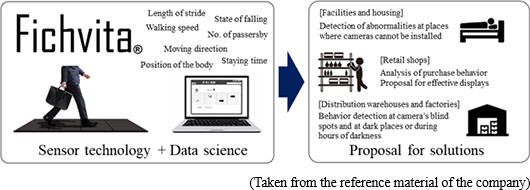 |
| Conclusions |
|
At "Toyo Ink Group Private Show 2018" held in May, they not only showcased products, but also gave seminars. The author attended the lecture of Mr. Tsuyoshi Sekitani, an honorary professor of Osaka University, titled "Material Technology that would Support the IoT Society."
Its subtitle was "Self-care of the brain at home-case of the structure health care technology." Professor Sekitani explained the feasibility of "early diagnosis and treatment of dementia," "control of the sleep state and improvement of its quality," etc. based on the brain measurement with a brain-wave sensor, but pointed out that it is necessary to dramatically reduce the cost of the IoT technology for measuring and processing extremely weak signals of brain waves, in order to distribute the items that are strongly demanded by society.
To do so, the material technology is essential. Accordingly, Professor Sekitani highly evaluated the technological capability of the Toyo Ink Group, and is conducting collaborative research.
In the short term, we would like to pay attention to how much they can absorb the adverse effect of escalation of material cost, which will linger in the second half, by revising prices, reforming the manufacturing process, etc. In the mid/long term, we would like to give attention to the progress of embodiment of IoT-related material technologies, including "Fichvita®."
|
| <Reference : Mid-Term Business Plan "SIC-I" (FY 2018 to FY 2020) > |
|
Under the long-term 10-year vision "Scientific Innovation Chain 2027 (SIC 27)" to realize sustainable growth for 2027, the company will develop a three-stage medium-term management plan every 3 years, clarify the challenges and roles, and act steadily for the future. It launched the first stage "Medium-Term Management Plan SIC-I (FY2018 - 2020)" this fiscal year.
<Basic policies>
The theme is "Frequent challenges"
By positioning the next medium-term management plan SIC-I (FY2018 - FY2020) as a period for building a foundation for sustainable growth in the next 100-year range, we will take successive measures for innovative change.
(1) Transformation of existing businesses and development of new businesses for growth
(2) Promotion of manufacturing innovation to increase sustainability
(3) Overhaul of management foundation
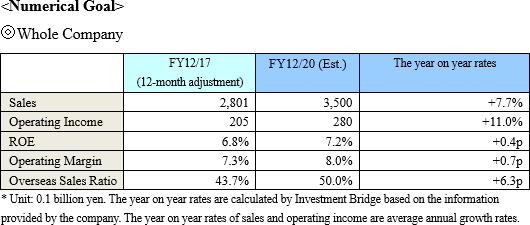 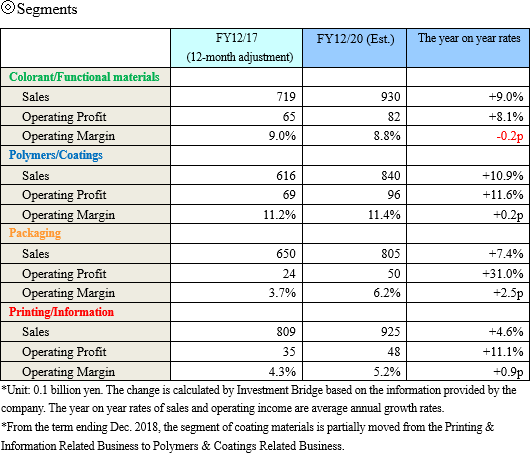 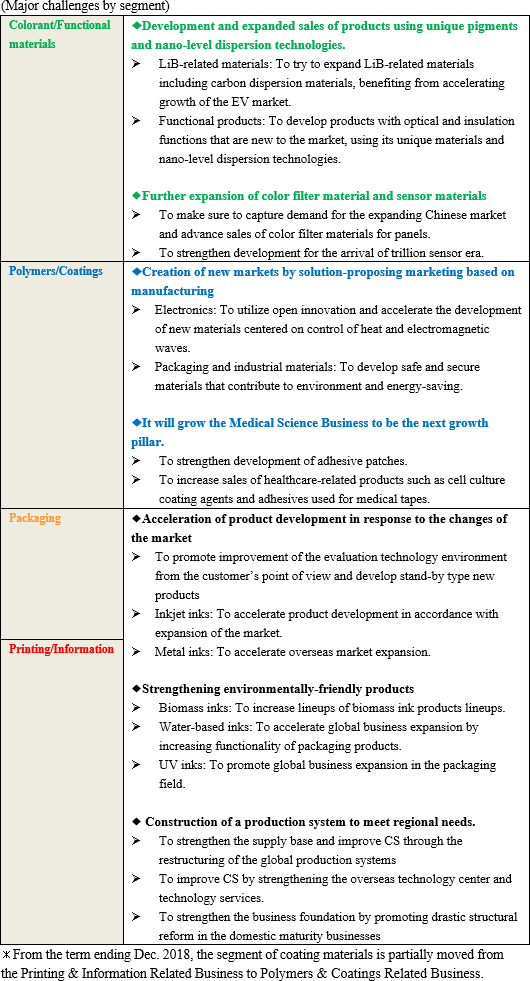 ◎ Investment plans
The company will set up a strategic investment frame separately from the traditional capital investment frame to expand priority domains and create new businesses, and it will make aggressive investment to achieve the plan.
◎ Investment plans
The company will set up a strategic investment frame separately from the traditional capital investment frame to expand priority domains and create new businesses, and it will make aggressive investment to achieve the plan.
 The strategic investment frame is an investment frame for transformation to expand priority domains and create new businesses, which will be described later. The company will take various actions, such as human resources and technology investment, to achieve the plan within this frame.
<Major measures>
(1) Transformation of Existing Businesses and Development of New Businesses for Growth
【1-1 Transformation of Existing Businesses】
The strategic investment frame is an investment frame for transformation to expand priority domains and create new businesses, which will be described later. The company will take various actions, such as human resources and technology investment, to achieve the plan within this frame.
<Major measures>
(1) Transformation of Existing Businesses and Development of New Businesses for Growth
【1-1 Transformation of Existing Businesses】
 Global development
To raise the growth capacity in overseas markets, it will promote the integration of global bases that have been established so far and the expansion of product lineups and will develop diverse businesses.
For pigment dispersions for inkjet inks and inks, in addition to manufacturing environmentally friendly products in China (Zhuhai), it will increase items in Japan, the US and France.
For laminate adhesives, it will try to increase sales in the food packaging market in cooperation with global bases that operate liquid ink business.
The company aims for increased sales of 53 billion yen compared with the term ended Dec. 2017. Global development
To raise the growth capacity in overseas markets, it will promote the integration of global bases that have been established so far and the expansion of product lineups and will develop diverse businesses.
For pigment dispersions for inkjet inks and inks, in addition to manufacturing environmentally friendly products in China (Zhuhai), it will increase items in Japan, the US and France.
For laminate adhesives, it will try to increase sales in the food packaging market in cooperation with global bases that operate liquid ink business.
The company aims for increased sales of 53 billion yen compared with the term ended Dec. 2017.
 Expansion of new products
The company will promote the development of new materials with a focus on pigments and resins and create new values by combining synthesis, dispersion and film formation technologies, which are its core technologies, to enter new markets and new areas.
Particularly, it will focus on electronics-related materials and medical/healthcare products in the Polymers & Coatings Related Business.
It aims for increased sales of 16 billion yen compared with the term ended Dec. 2017.
【1-2 Development of New Businesses】
The company set 6 priority domains in the SIC-I. To achieve sustainable growth, it will challenge the development of new business models centered on solution proposals that go beyond merely providing products and will link them to the activities in the "SIC-II" and "SIC-III" phases. Expansion of new products
The company will promote the development of new materials with a focus on pigments and resins and create new values by combining synthesis, dispersion and film formation technologies, which are its core technologies, to enter new markets and new areas.
Particularly, it will focus on electronics-related materials and medical/healthcare products in the Polymers & Coatings Related Business.
It aims for increased sales of 16 billion yen compared with the term ended Dec. 2017.
【1-2 Development of New Businesses】
The company set 6 priority domains in the SIC-I. To achieve sustainable growth, it will challenge the development of new business models centered on solution proposals that go beyond merely providing products and will link them to the activities in the "SIC-II" and "SIC-III" phases.
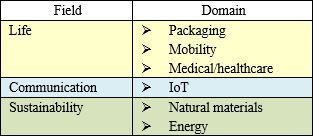 It will focus on the following 4 businesses.
[Sensor-related business]
The domains are mobility, medical/healthcare and IoT.
The company will focus on rapidly increasing "sensors" in the fast growing IoT market. In addition to "manufacturing" centered on chemicals, it will also try to develop sensor-related businesses that incorporate new technologies and provide "information and systems."
(Major products/services)
The major products/services are image sensor materials and sensor devices. In the "SIC -II" and "SIC -III" phases, development of data business based on sensing data will also be considered.
[Waste-heat from living related business]
The domains are mobility, IoT and energy.
Focusing on "waste-heat from living" which is unused in the surroundings of the living, the company will develop technologies to efficiently recycle the heat and work on a business that provides recycling energy solutions.
(Major products/services)
Heat resistant adhesive film, super heat resistant insulation/heat conductive film, high heat management parts, etc.
[Healthcare related business]
The domain is medical/healthcare.
Based on the adhesive patch business platform, the company will steadily expand its pharmaceutical business base and strengthen development and sales of peripheral healthcare-related materials.
(Major products/services)
Tapes for blood glucose test strips, medical adhesives, biocompatible polymers, next-generation adhesive patches, etc.
[Natural materials related business]
The domain is natural materials.
The company aims to further develop businesses of new functional natural materials making full use of edible pigments and bamboo-related products business platforms and advance the expansion of biomass products to further contribute to the low-carbon society.
(Major products/services)
Edible pigment products, Kuma bamboo grass related products, biomass inks, functional food materials, etc.
(2) Promotion of Manufacturing Innovation to Increase Sustainability
Until now, the company has been working on building a manufacturing network by proactively expanding overseas bases, building safe and secure manufacturing with consideration for the environment, and developing a global chemical substance management and trade management systems.
During the SIC-I phase, to contribute to the improvement of sustainability of ordinary citizens, life, and the global environment, it will tackle innovation in manufacturing for sustainable growth including the company itself and aim to achieve both contributing to sustainability and securing profitability.
(Example of actions)
It will focus on the following 4 businesses.
[Sensor-related business]
The domains are mobility, medical/healthcare and IoT.
The company will focus on rapidly increasing "sensors" in the fast growing IoT market. In addition to "manufacturing" centered on chemicals, it will also try to develop sensor-related businesses that incorporate new technologies and provide "information and systems."
(Major products/services)
The major products/services are image sensor materials and sensor devices. In the "SIC -II" and "SIC -III" phases, development of data business based on sensing data will also be considered.
[Waste-heat from living related business]
The domains are mobility, IoT and energy.
Focusing on "waste-heat from living" which is unused in the surroundings of the living, the company will develop technologies to efficiently recycle the heat and work on a business that provides recycling energy solutions.
(Major products/services)
Heat resistant adhesive film, super heat resistant insulation/heat conductive film, high heat management parts, etc.
[Healthcare related business]
The domain is medical/healthcare.
Based on the adhesive patch business platform, the company will steadily expand its pharmaceutical business base and strengthen development and sales of peripheral healthcare-related materials.
(Major products/services)
Tapes for blood glucose test strips, medical adhesives, biocompatible polymers, next-generation adhesive patches, etc.
[Natural materials related business]
The domain is natural materials.
The company aims to further develop businesses of new functional natural materials making full use of edible pigments and bamboo-related products business platforms and advance the expansion of biomass products to further contribute to the low-carbon society.
(Major products/services)
Edible pigment products, Kuma bamboo grass related products, biomass inks, functional food materials, etc.
(2) Promotion of Manufacturing Innovation to Increase Sustainability
Until now, the company has been working on building a manufacturing network by proactively expanding overseas bases, building safe and secure manufacturing with consideration for the environment, and developing a global chemical substance management and trade management systems.
During the SIC-I phase, to contribute to the improvement of sustainability of ordinary citizens, life, and the global environment, it will tackle innovation in manufacturing for sustainable growth including the company itself and aim to achieve both contributing to sustainability and securing profitability.
(Example of actions)
 Building the global supply chain based on co-existence and co-prosperity with our partners Building the global supply chain based on co-existence and co-prosperity with our partners
 Production process innovation integrated with digital technologies Production process innovation integrated with digital technologies
 Promotion of manufacturing to live with the global environment (energy savings, reduction of CO2 emissions, etc.)
(3) Overhaul of Management Foundation
It will drive forward global integration of business systems to reform existing business, create new businesses and reform manufacturing. It will also work on strengthening the management foundation including recruitment of personnel for reform and institutional reform (i.e. complete transition to defined contribution pension system, commencement of retirement age of 65). In addition, it will implement CSR activities integrated with management and contribute to the
improvement of the sustainability of ordinary citizens, life and the global environment.
It will strengthen the foundation to continuously create innovations.
(Example of actions) Promotion of manufacturing to live with the global environment (energy savings, reduction of CO2 emissions, etc.)
(3) Overhaul of Management Foundation
It will drive forward global integration of business systems to reform existing business, create new businesses and reform manufacturing. It will also work on strengthening the management foundation including recruitment of personnel for reform and institutional reform (i.e. complete transition to defined contribution pension system, commencement of retirement age of 65). In addition, it will implement CSR activities integrated with management and contribute to the
improvement of the sustainability of ordinary citizens, life and the global environment.
It will strengthen the foundation to continuously create innovations.
(Example of actions)
 Promotion of ERP integration globally and promotion of greater business efficiency using AI Promotion of ERP integration globally and promotion of greater business efficiency using AI
 Active recruitment of human resources necessary for innovative changes and the renovation of the personnel system to encourage innovations Active recruitment of human resources necessary for innovative changes and the renovation of the personnel system to encourage innovations
 Promotion of active CSR activities to achieve important issues (materiality) of TIG Promotion of active CSR activities to achieve important issues (materiality) of TIG
|
| <Reference : Regarding Corporate Governance> |
 ◎ Corporate Governance Report
The latest update: April. 10, 2018.
<Basic policy>
Our corporate group shifted to the holding company structure on April 1, 2011. Under the holding company structure, our company aims to improve the value of the entire corporate group by strengthening its strategic function, promoting speedy business administration, and achieve a good balance between the optimization of the entire group and the optimization of each business.
Our group's framework for business administration is constituted by the "ethos of the Toyo Ink Group," which is composed of management philosophy and ethos, which summarize the basic policies for group management, and the course of action, and the "CSR value system," which is composed of the CSR charter and course of action, which clearly describe the stance toward social responsibility.
Our group aims to contribute to the improvement of sustainability of residents, life, and the earth environment and become "an enterprise that can create lifestyles and cultures that would spread around the world" as set in the management ethos, through science-based manufacturing, by putting the "ethos of the Toyo Ink Group" and the "CSR value system" into practice.
In order to create tangible and intangible values as an enterprise and fulfill social responsibility, it is indispensable to self-evaluate corporate activities from the viewpoint of stakeholders and carry out well-balanced business administration for economic, social, personnel, and environmental affairs.
To do so, our company will: ◎ Corporate Governance Report
The latest update: April. 10, 2018.
<Basic policy>
Our corporate group shifted to the holding company structure on April 1, 2011. Under the holding company structure, our company aims to improve the value of the entire corporate group by strengthening its strategic function, promoting speedy business administration, and achieve a good balance between the optimization of the entire group and the optimization of each business.
Our group's framework for business administration is constituted by the "ethos of the Toyo Ink Group," which is composed of management philosophy and ethos, which summarize the basic policies for group management, and the course of action, and the "CSR value system," which is composed of the CSR charter and course of action, which clearly describe the stance toward social responsibility.
Our group aims to contribute to the improvement of sustainability of residents, life, and the earth environment and become "an enterprise that can create lifestyles and cultures that would spread around the world" as set in the management ethos, through science-based manufacturing, by putting the "ethos of the Toyo Ink Group" and the "CSR value system" into practice.
In order to create tangible and intangible values as an enterprise and fulfill social responsibility, it is indispensable to self-evaluate corporate activities from the viewpoint of stakeholders and carry out well-balanced business administration for economic, social, personnel, and environmental affairs.
To do so, our company will:
 transfer the business execution function to each business company, and appropriately enforce the regulations for internal memos and affiliate management, which are adapted to each group company, in order to fortify corporate governance, transfer the business execution function to each business company, and appropriately enforce the regulations for internal memos and affiliate management, which are adapted to each group company, in order to fortify corporate governance,
 develop its internal control system, develop its internal control system,
 improve the instruction and monitoring functions by enhancing the legal functions and systems, such as general meetings of shareholders, the board of directors, the board of auditors, comptrollers, etc., improve the instruction and monitoring functions by enhancing the legal functions and systems, such as general meetings of shareholders, the board of directors, the board of auditors, comptrollers, etc.,
 improve the transparency of business administration by disclosing information swiftly, accurately, and broadly, improve the transparency of business administration by disclosing information swiftly, accurately, and broadly,
 strengthen and enrich its compliance system, strengthen and enrich its compliance system,
 promote environmental conservation on a global scale, and so on,
and foster good relationships with stakeholders, including shareholders, business partners, local communities, and employees, and enhance corporate governance.
<Reasons for Non-compliance with the Principles of the Corporate Governance Code (Excerpts)>
Our company implements all the principles of the corporate governance code. promote environmental conservation on a global scale, and so on,
and foster good relationships with stakeholders, including shareholders, business partners, local communities, and employees, and enhance corporate governance.
<Reasons for Non-compliance with the Principles of the Corporate Governance Code (Excerpts)>
Our company implements all the principles of the corporate governance code.
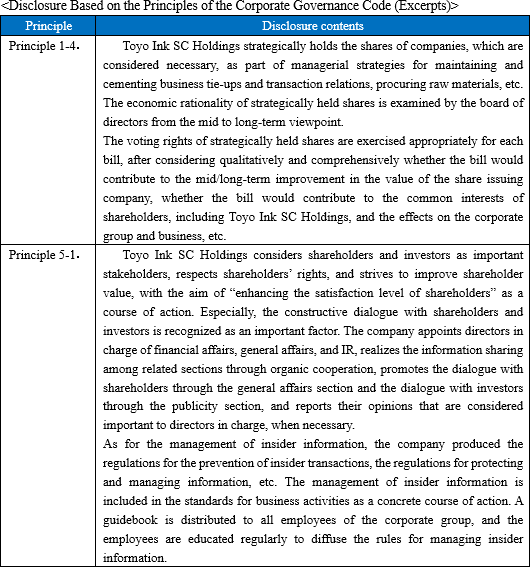 |
|
Disclaimer
This report is intended solely for information purposes, and is not intended as a solicitation for investment. The information and opinions contained within this report are made by our company based on data made publicly available, and the information within this report comes from sources that we judge to be reliable. However we cannot wholly guarantee the accuracy or completeness of the data. This report is not a guarantee of the accuracy, completeness or validity of said information and opinions, nor do we bear any responsibility for the same. All rights pertaining to this report belong to Investment Bridge Co., Ltd., which may change the contents thereof at any time without prior notice. All investment decisions are the responsibility of the individual and should be made only after proper consideration..Copyright(C) 2018 Investment Bridge Co., Ltd. All Rights Reserved. |

